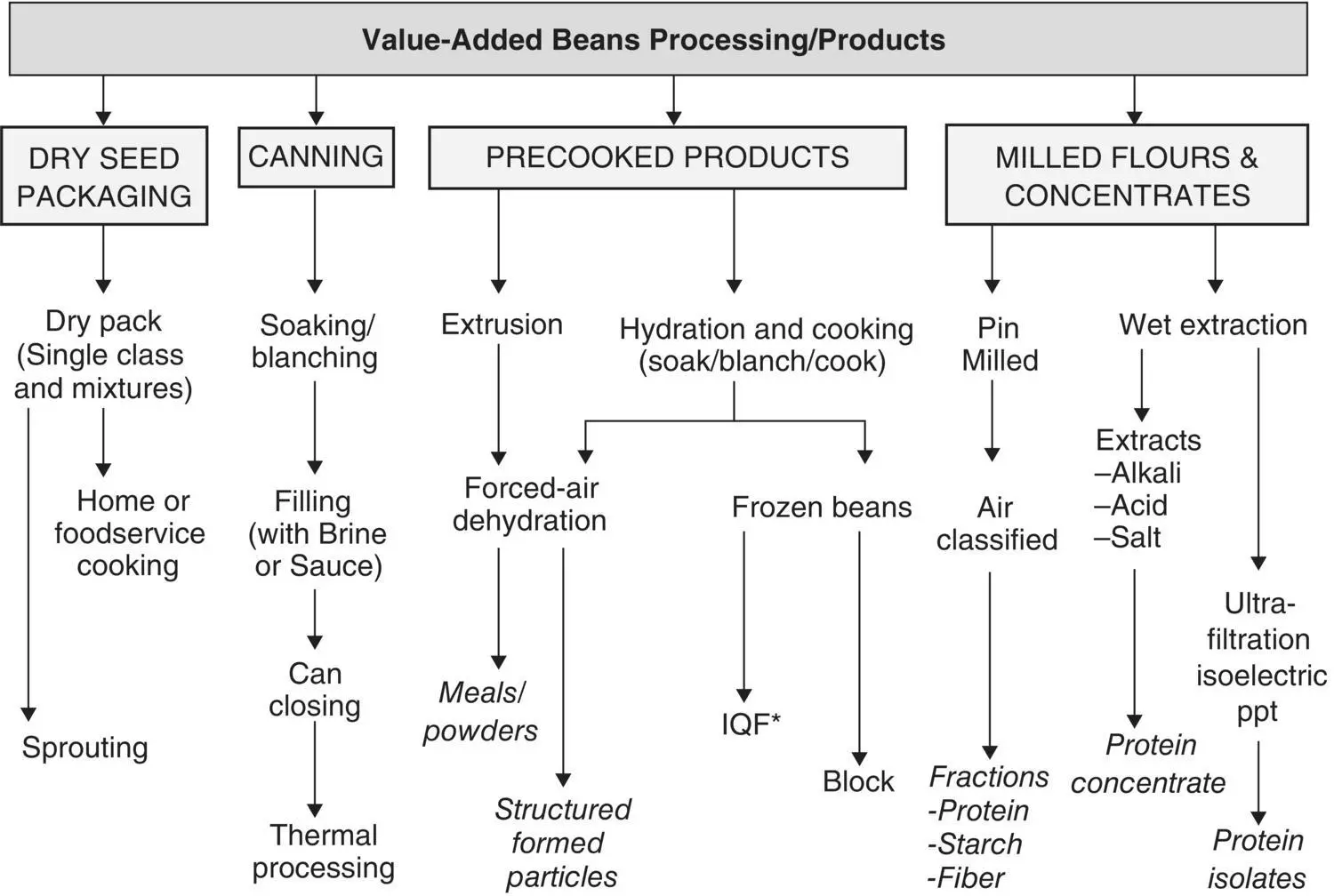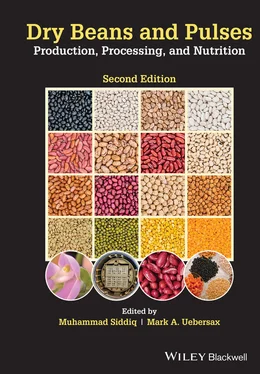Dry Beans and Pulses Production, Processing, and Nutrition
Здесь есть возможность читать онлайн «Dry Beans and Pulses Production, Processing, and Nutrition» — ознакомительный отрывок электронной книги совершенно бесплатно, а после прочтения отрывка купить полную версию. В некоторых случаях можно слушать аудио, скачать через торрент в формате fb2 и присутствует краткое содержание. Жанр: unrecognised, на английском языке. Описание произведения, (предисловие) а так же отзывы посетителей доступны на портале библиотеки ЛибКат.
- Название:Dry Beans and Pulses Production, Processing, and Nutrition
- Автор:
- Жанр:
- Год:неизвестен
- ISBN:нет данных
- Рейтинг книги:5 / 5. Голосов: 1
-
Избранное:Добавить в избранное
- Отзывы:
-
Ваша оценка:
- 100
- 1
- 2
- 3
- 4
- 5
Dry Beans and Pulses Production, Processing, and Nutrition: краткое содержание, описание и аннотация
Предлагаем к чтению аннотацию, описание, краткое содержание или предисловие (зависит от того, что написал сам автор книги «Dry Beans and Pulses Production, Processing, and Nutrition»). Если вы не нашли необходимую информацию о книге — напишите в комментариях, мы постараемся отыскать её.
The second edition of the most complete and authoritative reference on dry beans production, processing, and nutrition available Dry Beans and Pulses: Production, Processing, and Nutrition
Dry Beans and Pulses: Production, Processing, and Nutrition, Second Edition
Dry Beans and Pulses Production, Processing, and Nutrition — читать онлайн ознакомительный отрывок
Ниже представлен текст книги, разбитый по страницам. Система сохранения места последней прочитанной страницы, позволяет с удобством читать онлайн бесплатно книгу «Dry Beans and Pulses Production, Processing, and Nutrition», без необходимости каждый раз заново искать на чём Вы остановились. Поставьте закладку, и сможете в любой момент перейти на страницу, на которой закончили чтение.
Интервал:
Закладка:
In many developing countries, women provide a central role focused on sustaining the family’s food security. Traditional cooking of dry edible beans in these countries involves excessive expenditure of time and fuel. The development of appropriate preparation technologies for use at the household and village‐level would facilitate processing and dietary availability of beans and other pulses (Siddiq and Uebersax 2012).
Beans and maize in blended dishes are deeply imbedded throughout Latin American cultures and transcends to other people groups. This is due in part to the inherent complementation of amino acids resulting in a more complete protein food. Sub‐Saharan Africa utilizes a wide range of dry beans and other pulses (i.e., cowpea, chickpeas, lentils, and others). These are typically water cooked and eaten as porridge. The subcontinent of India uses the greatest quantity and most diversity of pulse‐based foods as staples, prepared in very specialized recipes and forms. The consumption of legumes in Southeast Asia is somewhat moderate, where both mature seeds and immature pods are consumed. Further, sprouted legume seeds are consumed fresh or dehulled and roasted or ground for use in soups or side dishes (Khader and Uebersax 1989; Borchgrevink 2012).
Value‐added processing and products
Beans typically require dry cleaning and sorting, gentle handling to assure a minimum degree of mechanical damage, and soaking and blanching prior to filling and thermal processing. The popularity of convenience foods such as dehydrated, extruded, frozen, and microwavable food products has provided a venue for the development of new bean products or bean formulations ( Figure 1.6 ). The use of pulses was projected to expand as plant‐ based protein alternatives for meat. Further, in combination with cereal raw materials, they may find new applications, meeting both sensory and nutritional needs of consumers worldwide (Sozer et al. 2017).

Fig. 1.6. A sampling of valued‐added dry bean products (*Individually quick frozen)
Source: Adapted from Uebersax et al. (1989, 1991).
Selected categories of dry bean‐based products utilized in industrialized regions include packaged dry beans, canned beans (beans in brine or specialty sauces), precooked bean products (precooked and dehydrated bean flakes and powders), extruded and pasta‐type products, specialized food ingredients (meals, flours, concentrates, powders, and flakes), quick‐cooking beans, and frozen beans. In the developed nations, canned products consistently dominate bean usage (based on individual frequencies of use data and total sales volume) compared with dry beans distributed in prepackaged retail offerings or through direct bulk dispensing (Siddiq and Uebersax 2012). Legume derived ingredients, i.e., flours and isolates, are being used on increasing levels for processing a variety of products, such as baked goods, fried products, and extruded snacks (Fernando 2021; Hall 2021).
NUTRITIONAL PROFILE AND HEALTH BENEFITS
The characteristics that make beans and pulses a good food value are health and wellness . It is noteworthy that consumers are increasingly selecting healthy and balanced diets proportionally higher in plant–based foods. Dry beans and other pulses have significant nutritional and health advantages for consumers since they are high in proteins and dietary fiber and very low in fat; and are environmentally sustainable, e.g., advantages associated with nitrogen fixation in soils by legumes (Uebersax 2006; Clemente and Olias 2017). Generally, rural populations consume greater levels of legumes than the contrasting urban populations, because of the dependence on locally produced foods. People of subsistent or lower‐income levels generally consume larger quantities of beans, which furthers the stereotype that “beans are poor man’s steak,” which often stigmatizes and denigrates bean use and reduces expanded utilization (Siddiq and Uebersax 2012).
Nutritional profile
Legumes are a good source of protein, dietary fiber, starch, minerals, and vitamins (Kutos et al. 2002; Hayat et al. 2014; Venkidasamy et al. 2019). Table 1.5 shows a compositional comparison of dry beans with major cereal grain crops. In comparison to these cereal grains, beans are relatively high in proteins and dietary fiber while low in carbohydrates and fat. Detailed composition of selected dry beans and pulses in presented in Table 1.6 .
The 2015–2020 Dietary Guidelines for US Americans (DGA) classify mature legumes as a food group with a weekly recommendation of 1.5 cups (equivalent to 37.5 g cooked mature legumes/day) for nonvegetarians and 3 cups (equivalent to 75 g cooked mature legumes/day) for vegetarians (USDHHS and USDA 2021). The most recent DGA (2020–2025), issued in December 2020, make similar recommendations for legume consumption; however, further emphasize on reduction in added sugars and a greater focus on stages of life requirements (infants, children and adolescents, adults, pregnant/lactating women, and older adults).
Health benefits
Health benefits of legumes have been researched extensively and reported in the literature (Mudryj et al. 2014; Maphosa and Jideani 2017; Kamboj and Nanda 2018; Perera et al. 2020). The role of legumes as therapeutic agents in the diets of persons suffering from metabolic disorders has gained some research interest (Chugh et al 2017; Budhwar and Chakraborty 2020; Tiwari et al. 2020). Public health officials recommend increasing the proportion of legume‐based polymeric plant carbohydrates in the diet. For example, regular consumption of dry beans in the USA, where obesity is on the rise, has been suggested to significantly improve the diet quality (Mitchell et al. 2009). In recent years, heightened consumer awareness has led to the promotion of less saturated fat, cholesterol, sugar, and salt in the diet and the preference for complex carbohydrates such as fiber from legumes. However, with growing urbanization even in the developing countries, ready‐to‐eat foods play a major role in the food consumption pattern (Njintang et al. 2001).
Table 1.5. Comparison of nutritional profiles of dry beans, chickpea and lentil with other grains (per 100 g).
Source: Adapted from USDA (2021).
| Nutritional profile | Dry beans 1 | Chickpea | Lentil | Wheat | Oat | Corn |
|---|---|---|---|---|---|---|
| Energy (kcal) | 341 | 378 | 352 | 339 | 389 | 361 |
| Protein (g) | 21.97 | 20.47 | 24.63 | 13.7 | 16.89 | 6.93 |
| Carbohydrate (g) | 61.74 | 62.95 | 63.35 | 72.57 | 66.27 | 76.85 |
| Dietary fiber (g) | 15.38 | 12.2 | 10.70 | 12.2 | 10.6 | 7.3 |
| Total lipid/fat (g) | 1.30 | 6.04 | 1.06 | 1.87 | 6.9 | 3.86 |
| Iron (mg) | 5.57 | 4.31 | 6.51 | 3.88 | 4.72 | 2.38 |
| Potassium (mg) | 1355 | 718 | 677 | 405 | 429 | 315 |
| Folate (μg) | 432 | 557 | 479 | 44 | 56 | 25 |
1 Average of pinto, navy, red kidney, and black beans
Table 1.6. Composition of selected dry beans and pulses (per 100 g).
Source: USDA (2021).
| Unit | Pinto bean | Navy bean | Black bean | Red kidney bean | Cowpea | Chickpea | Lentil | |
|---|---|---|---|---|---|---|---|---|
| Proximate: | ||||||||
| Water | g | 11.33 | 12.1 | 11.02 | 11.75 | 11.05 | 7.68 | 8.26 |
| Energy | kcal | 347 | 337 | 341 | 337 | 343 | 378 | 352 |
| Energy | kJ | 1452 | 1411 | 1425 | 1408 | 1435 | 1581 | 1473 |
| Protein | g | 21.42 | 22.33 | 21.6 | 22.53 | 23.85 | 20.47 | 24.63 |
| Total lipid (fat) | g | 1.23 | 1.5 | 1.42 | 1.06 | 2.07 | 6.04 | 1.06 |
| Carbohydrate | g | 62.55 | 60.75 | 62.36 | 61.29 | 59.64 | 62.95 | 63.35 |
| Fiber, total dietary | g | 15.5 | 15.3 | 15.5 | 15.2 | 10.7 | 12.2 | 10.7 |
| Total sugars | g | 2.11 | 3.88 | 2.12 | 2.1 | 10.7 | 2.03 | |
| Minerals: | ||||||||
| Calcium | mg | 113 | 147 | 123 | 83 | 85 | 57 | 35 |
| Iron | mg | 5.07 | 5.49 | 5.02 | 6.69 | 9.95 | 4.31 | 6.51 |
| Magnesium | mg | 176 | 175 | 171 | 138 | 333 | 79 | 47 |
| Phosphorus | mg | 411 | 407 | 352 | 406 | 438 | 252 | 281 |
| Potassium | mg | 1393 | 1185 | 1483 | 1359 | 1375 | 718 | 677 |
| Sodium | mg | 12 | 5 | 5 | 12 | 58 | 24 | 6 |
| Zinc | mg | 2.28 | 3.65 | 3.65 | 2.79 | 6.11 | 2.76 | 3.27 |
| Vitamins: | ||||||||
| Vitamin C 1 | mg | 6.3 | 0 | 4.5 | 1.5 | 4 | 4.5 | |
| Thiamin | mg | 0.713 | 0.775 | 0.9 | 0.608 | 0.68 | 0.477 | 0.873 |
| Riboflavin | mg | 0.212 | 0.164 | 0.193 | 0.215 | 0.17 | 0.212 | 0.211 |
| Niacin | mg | 1.174 | 2.188 | 1.955 | 2.11 | 2.795 | 1.541 | 2.605 |
| Vitamin B‐6 | mg | 0.474 | 0.428 | 0.286 | 0.397 | 0.361 | 0.535 | 0.54 |
| Folate, DFE 2 | μg | 525 | 364 | 444 | 394 | 639 | 557 | 479 |
| Vitamin A, IU | IU | 0 | 0 | 17 | 0 | 67 | 39 | |
| Vitamin E 3 | mg | 0.21 | 0.02 | 0.21 | 0.21 | 0.82 | 0.49 | |
| Vitamin K 4 | μg | 5.6 | 0.17 | 5.6 | 5.6 | 9 | 0 |
1 total ascorbic acid;
Читать дальшеИнтервал:
Закладка:
Похожие книги на «Dry Beans and Pulses Production, Processing, and Nutrition»
Представляем Вашему вниманию похожие книги на «Dry Beans and Pulses Production, Processing, and Nutrition» списком для выбора. Мы отобрали схожую по названию и смыслу литературу в надежде предоставить читателям больше вариантов отыскать новые, интересные, ещё непрочитанные произведения.
Обсуждение, отзывы о книге «Dry Beans and Pulses Production, Processing, and Nutrition» и просто собственные мнения читателей. Оставьте ваши комментарии, напишите, что Вы думаете о произведении, его смысле или главных героях. Укажите что конкретно понравилось, а что нет, и почему Вы так считаете.












